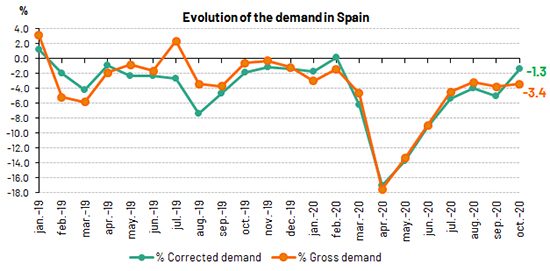We are a global operator of essential infrastructure
- 46.7% of monthly generation came from renewable sources and 69.4% was produced from technologies that do not emit CO2 emissions.
- Annual cumulative hydro production up to the end of October exceeds the total amount generated using this same technology in 2019.
- Demand for electricity in the Balearic Islands fell by 24.6% and in the Canary Islands by 11% compared to October 2019.
The national electricity demand in October is estimated at 20,722 GWh, 3.4% lower than in the same month last year. After having factored in the influence of seasonal and working patterns, demand is 1.3% lower than that registered in the October 2019.
In the first ten months of 2020, demand is estimated at 206,745 GWh, 6.3% less than in 2019. After having factored in the influence of seasonal and working patterns, this figure remains unchanged.

In October, and according to data estimated at the time of this press release, generation coming from renewable energy sources represented 46.7% of the total production. So far this year, renewable generation has produced 19.4% more than in the same period in 2019. Therefore, from January to October 2020, renewable generation reached a share of 43.5% of the total electricity generated nationwide.
Additionally, 69.4% of electricity generation during October was obtained using technologies which produce zero CO2 emissions.
With information available as at the time of this press release, wind energy generation in October reached 5,724 GWh, a figure that is 50.2% higher than in the same period last year, and represented 27.3% of total production nationwide, ranking as the leading technology in the generation mix, followed by nuclear (21.6%) and combined cycle (15.3%).
It should be noted that on 29 October, annual hydro production exceeded the grand total for the whole of 2019. This renewable technology, responsible for 12% of the total electricity generated from January to October 2020, has increased its production by 43.2% compared to the same period last year.

Demand for electrical energy in the peninsular electricity system drops 2.6%
Demand for electrical energy in the peninsular electricity system in the month of October is estimated at 19,629 GWh, a value 2.6% lower than that recorded in the same month last year. After having factored in the influence of seasonal and working patterns, the demand for electricity is 0.5% lower than that registered in October 2019.
In the first ten months of 2020, the demand for electricity on the Spanish Peninsula is estimated at 195,618 GWh, a figure that is 5.7% lower than in 2019. In this case, after having factored in the influence of seasonal and working patterns, demand is 5.8% lower than in the same period of the previous year.
During October, and according to data estimated at the time of this press release, 48.3% of the peninsular generation came from renewable energy sources and 72.1% was obtained using technologies which produce zero CO2 emissions. For its part, wind energy stood at 5,621 GWh, 51.1% more than in October last year, and became the leading technology contributing 28.1% to the overall generation mix.
Demand for electricity in October decreased 24.6% in the Balearic Islands and 11.0% in the Canary Islands
In the Balearic Islands, the demand for electricity in October is estimated at 369,664 MWh, a value that is 24.6% lower than that registered in the same month last year. After having factored in the influence of seasonal and working patterns, the figure decreases by 22.6% with respect to October 2019. In the first ten months of 2020, demand in the Balearic Islands is estimated at 4,141,747 MWh, 21.6% less than in the same period in 2019.
Combined cycle, with 55.5% of the total, was the leading source of electricity generation in the Balearic Islands in October, a month in which renewable technologies and those which produce zero CO2 emissions accounted for 6.1% of the generation mix for the month.
Regarding the Canary Islands, electricity demand is estimated at 688,572 MWh, 11% down on that registered in the same month last year. After having factored in the influence of seasonal and working patterns, the figure falls by 10.4% with respect to October 2019. In the first 10 months of 2020, demand in the Canary Islands is estimated at 6,641,397 MWh, a decrease of 10.2% on the same period in 2019.
In October, combined cycle, with 38.1% of the total, was the leading source of electricity generation on the Canary Islands. Renewable technologies and those which produce zero CO2 emissions accounted for 18.1% of the total generation on the Canary Islands.
Consult our Daily Balance Report for more information on the National, Peninsular, Balearic Islands and Canary Islands electricity systems as at the close of October.














